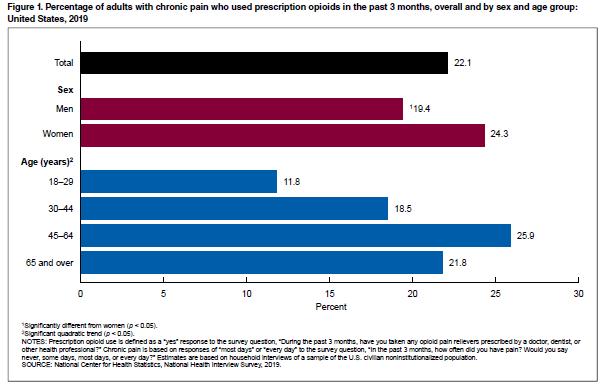Prescription Opioid Use Among Adults With Chronic Pain: United States, 2019
Posted on byQuestions for Jim Dahlhamer, Health Statistician and Lead Author of “Prescription Opioid Use Among Adults With Chronic Pain: United States, 2019.”

Q: Why did you decide to do a report on prescription opioid use among U.S. adults with chronic pain?
JD: The latest estimate from NHIS reveals that just over 20% of U.S. adults experience chronic pain. Opioids are widely prescribed for the treatment of chronic pain in this country, even though questions remain as to their efficacy for such treatment. In the context of chronic pain management, some studies have shown prescription opioid use to be associated with an increased risk of misuse, addiction, morbidity, and mortality. Yet, surprisingly, we found only a handful of national estimates of prescription opioid use among adults with chronic pain. With that in mind, our goal was to produce national estimates of prescription opioid use among adults with chronic pain, overall and by sociodemographic and socioeconomic characteristics such as age, sex, educational attainment, and poverty status. Our hope is that the report provides baseline estimates for continued surveillance of prescription opioid use among adults with chronic pain. These and future results may shed light on subgroups potentially at higher risk of negative outcomes associated with prescription opioid use.
Q: How does the data vary by different demographics?
JD: Prescription opioid use among adults with chronic pain varied across a range of sociodemographic and socioeconomic subgroups. We found that men and employed adults were less likely to have used a prescription opioid compared with women and not employed adults. Prescription opioid use increased with age among adults aged 18–64 and decreased among adults aged 65 and over. Adults from higher socioeconomic backgrounds, as measured by their educational attainment and family income as a percentage of the federal poverty level, were less likely to have used prescription opioids compared with those from lower socioeconomic backgrounds. Finally, adults with private health insurance coverage, Medicare, or Medicaid or other forms of public coverage were more likely to have used a prescription opioid than uninsured adults.
Q: Do you have trend data?
JD: NHIS included questions on pain and opioid use in 2020, so this analysis could be repeated to see how these estimates may have changed, especially in the context of COVID-19. However, opioid questions are not included on the 2021 NHIS and we don’t know at this time when they may be asked in the future.
Q: What is the take home message in this report?
JD: Nearly a quarter of U.S. adults with chronic pain used a prescription opioid in the past 3 months, with use varying across a range of sociodemographic and socioeconomic subgroups. Estimates in this report can be used as a starting point for continued monitoring of prescription opioid use among adults with chronic pain in the U.S., potentially shedding light on subgroups at greater risk of negative outcomes associated with opioid use.
Q: Do you have data on prescription opioid use by state?
JD: Data on prescription opioid use by state would be available through the NCHS Research Data Center. We have not looked at the data by state so we can’t speak to the number of states for which reliable estimates could be produced. It is likely that number would increase once 2020 data are available as a data user could then combine or pool 2019 and 2020 data.
Posted on by

